The History Of Pontiac Grand AM

The Pontiac Grand Am was originally a mid-size car and later a compact car that was produced by the Pontiac division of General Motors. The Grand Am had two separate 3-year runs in the '70s: from 1973 to 1975 and again from 1978 to 1980. It was based on the GM A platform. Production of the Grand Am was canceled in 1980 when it was replaced by the Pontiac 6000. The Grand Am was reintroduced in 1985 when it replaced the Pontiac Phoenix. It was Pontiac's best selling car and later replaced by the Pontiac G6, so named as it was intended to be the 6th generation of the Grand Am. Grand Ams were built between 1973 and 1985 in Pontiac, Michigan at Pontiac's main assembly plant and [Atlanta, Ga] at GMAD Lakewood. All Grand Ams between 1985 and 2005 were built in Lansing, Michigan at the Lansing Car Assembly.
The original Grand Am was introduced in the fall of 1972 as a 1973 model. It was based on the GM A-body platform along with other cars such as the Pontiac LeMans, Pontiac GTO, Chevrolet Chevelle, Buick Century, and the Oldsmobile Cutlass Supreme. The GM A-body platform had major design revisions in 1973 that included the elimination of pillarless hardtops due to proposed federal rollover standards, but with frameless windows similar to that of a hardtop. No convertibles were produced due to those same federal rollover standards (that never were enacted). In addition to federal emissions regulations that reduced performance, new federal standards required a 5mph (8.0km/ h) impact-resistant front bumper and a 2.5mph (4.0km/ h) impact-resistant rear bumper, which increased to 5mph (8.0km/ h) for 1974.
1973
The Grand Am, coined by Pontiac with a name derived from two other cars in its lineup ("Grand" signifying "Grand Prix luxury" and "Am" for "Trans Am performance") was designed as American's answer to European luxury/ sport sedans and available as a 4-door Colonnade sedan or a 2-door Colonnade coupe. 43,136 Grand Ams were built during the first year of production (both two door and four door models).
The Grand Am could be had with a standard 400/ 2bbl engine (170 horsepower), an optional 400/ 4bbl engine (230 horsepower), or an optional 455/ 4bbl engine (250 horsepower). Originally planned but never materialized was the availability of 310horsepower (230kW) Super Duty 455/ 4bbl that was originally set to be available on several 1973 Pontiac models including the Grand Am, Grand Prix and GTO along with the Firebird Trans Am and Formula. However, production of the 455 SD was delayed from its planned debut at the start of the model year due to emissions considerations. Production of the 455 SD was delayed until the spring of 1973 and then it was made available only on the two Firebird models. One early '73 Grand Am prototype was reportedly assembled with the 455 SD engine.
The 400/ 2bbl, 400/ 4bbl, and 455/ 4bbl engines were available with a Turbo-hydramatic 400 automatic as standard equipment. A 4-speed manual transmission was available with the 400/ 4bbl engine in 1973 and 1974. It is unknown how many of the 1973 model year Grand Ams had the four-speed manual transmission, but it is estimated to be in the 600-900 range for 1973 and perhaps half that in 1974. The four speed manual transmission was available only with the 400/ 4bbl engine. All 400/ 2bbl and 455/ 4bbl equipped cars were automatics.
The 1973 Pontiac Grand Am style had a unique flexible urethane front fascia center nose that was squeezable and could return back to its original shape following a minor collison, a total of 6 grille openings with vertical bars, round front turn signals, horizontal rear tail lights, and chrome rear bumper. Additionally, Grand Ams featured a Radial Tuned Suspension (RTS) as standard equipment which included the radial-ply tires, Pliacell shock absorbers and front and rear sway bars for improved ride and handling. This basic suspension tuning also came standard with the Grand Prix SJ option in 1973 and optional on two other Pontiac models that year including the full-sized Bonneville and the sporty Firebird. The Grand Am was one of only three GM cars to come standard with radial tires and appropriate suspension tuning in 1973 with the others being the Oldsmobile Cutlass Salon and Chevrolet Monte Carlo S.
Inside, the Grand Am came standard with Strato bucket seats upholstered in Naugahyde vinyl or corduroy cloth featuring recliners and adjustable lumbar support - both features common on European-style sports/ luxury sedans but unusual for American cars of that time. Also included were an instrument panel from the Pontiac Grand Prix featuring a Rally Gauge Cluster with full instrumentation (tachometer optional-on cars so equipped, the clock was moved to a space on the lower instrument panel under the radio), three-spoke steering wheel with large padded hub and Genuine Crossfire Mahogany trim on the dash facing, radio and clock surrounds, as well as the center console between the front seats. Grand Ams also were among the first U.S.-built cars to come with a turn-signal mounted headlight dimmer switch that had been common on imported cars for decades.
Pontiac also produced a single 1973 Grand Am station wagon as a feasibility study. This was a LeMans wagon converted to a Grand Am. A functional ram-air induction system was developed for the Pontiac A-bodies utilizing twin NACA openings in the hood, but the option was dropped due to inability to pass federally mandated drive-by noise standards. A few functional Ram Air systems were sold over the counter, but are extremely rare. The twin-scoop NACA hood was an option for any Pontiac A-body for all three years, but was non-functional.
1974
Described as "The mid-sized Pontiac with Foreign Intrigue ... American Ingenunity" on the front cover of the four-page 1974 Grand Am brochure that featured a green four-door sedan, only minor styling changes highlighted this year's model including a refined front urethane fascia with a redesigned nose and grille with 12 openings with horizontal bars. 1974 Grand Ams had The rear end styling was redesigned for the new 1974 5mph crash standards and had vertical rear taillights with relocated license plate and fuel filler above the bumper. Engine and transmission offerings were the same as 1973, but four-speed manual transmissions were no longer offered in California, there it was Turbo Hydra-matic or nothing. Inside, the Genuine African Crossfire Mahogany trim on the instrument panel was replaced by a simulated material due to splintering problems on the '73 models but the real wood was continued on the center console.
Sales were down more than 50 percent from 1973 due to the energy crisis resulting from the late-1973 and early-1974 Arab Oil Embargo which led to long lines for short supplies of gasoline at service stations and dramatic increases in fuel prices, plus a severe recession and tremendous priced increases for all 1974 model cars due to inflation and the new safety and emission control devices. Only 17,083 Grand Ams were built this year with very few being four-door sedans.
1975
The 1975 Grand Am looked the same as the 1974 model, but had vertical front grille bars, a body-colored rear bumper, and a single-exhaust catalytic converter which mandated the use of unleaded fuel along with GM's High Energy Ignition and other items promoted as part of Pontiac's Maximum Mileage System. In addition to the standard roofline with louvered rear side windows, Grand Am coupes with the optional vinyl roof could be ordered with a full triangular rear side window or a vertical opera window similar to that found on the Grand Prix.
Inside, the Strato bucket seats received revised vertical trim patterns, the adjustable lumbar support controls were dropped and only the passenger seat had a recliner. New this year as a no-cost option was a 60/ 40 bench seat with center armrest.
The advent of the catalytic converter spelled the end of dual exhausts this year. Engines were also detuned to meet the 1975 emission regulations with compression ratios dropping to a new low of 7.6 to 1 on some engines. Standard engine was the 170-horsepower 400 V8 with two-barrel carb, optional were a 185-horsepower 400 or 200-horsepower 455 - both with four-barrel carburetors. Turbo Hydra-matic was standard equipment and the only transmission offered this year.
Only 10,679 Grand Ams were built in 1975 and the series was dropped after this year due to declining sales and rising gas prices as a result of the 1973 OPEC oil embargo. Also a factor leading to the Grand Am's cancellation were plans for all 1976 Pontiac A-body cars receiving the new rectangular headlights which would necessitate a complete redesign of the Grand Am's urethane nose and Pontiac officials decided that the expense of such a redesign could not be justified based on low production numbers. All 1973-1975 Grand Ams were built at the Pontiac, MI assembly plant, which was the home plant of the Pontiac Motor Division. The basic GM A-body design remained until 1977.
Factors that led to the demise of the first-gen Grand Am
By the time the first-generation Grand Am was discontinued in 1975, rising fuel prices had made the public more aware of the importance of fuel economy. The combination of numerically lower rear axle ratios (to improve fuel economy) and 1975 federal emissions standards all but killed performance, which was the final nail in the coffin for the muscle car era. Although designed to compete with European sport/ luxury sedans, the Grand Am was considerably larger and heavier than its intended imported competition which was more in the size and weight class of U.S. built compacts - and much bigger than the largest cars built in most nations outside of North America. Detroit also began to offer upgraded luxury compacts such as the Ford Granada, Mercury Monarch and even Pontiac's own Ventura SJ, along with the similar-bodied Chevrolet Nova LN, Buick Skylark S/ R and Oldsmobile Omega Salon. They offered similarly luxurious interior appointments and improved suspension tuning, but in smaller packages better designed to challenge the imported sedans. Furthermore, the Grand Am's Radial Tuned Suspension (RTS) package that was unique when the Grand Am was introduced in 1973 would become optional equipment on all other Pontiac and GM models in 1974 and made standard equipment throughout most car lines by 1975, (around this time the automotive industry was switching to radial-ply tires) so the Grand Am's lost yet another bit of uniqueness.
Engines
- 1973-1975 400CID (6.5 L) V8 with 2-barrel carburetor (standard engine, others were optional)
- 1973-1975 400CID (6.5 L) V8 with 4-barrel carburetor
- 1973-1974 400CID (6.5 L) V8 with 4-barrel carburetor, 4-speed (not available in California)
- 1973-1975 455CID (7.4 L) V8 with 4-barrel carburetor
Notes:
- 1973 engines may have point or unitized ignition.
- A SD-455 equipped engineering prototype Grand Am was built, but was dismantled and destroyed.
- 1974 engines may have point or unitized ignition or starting around May 1, 1974, HEI.
- 1975 engines have HEI.
- 1975 was the first year for the catalytic converter.
1978
The Grand Am returned in 1978, based on the Grand Prix's A platform, which had been downsized from the previous generation. The Grand Am was offered in both two- and four-door models with a vertical bar grille and other trimmings to differentiate it from the LeMans upon which it was based. Like the 1973-75 models, this generation of Grand Ams also featured standard radial tires plus an upgraded Radial Tuned Suspension with front and rear sway bars. Interiors were similar to the Grand LeMans with either a standard notchback bench seat, optional 60/ 40 bench or Strato bucket seats with console and recliner on passenger side, and a choice of either cloth or Morrokide vinyl upholstery.
Standard equipment includes power steering, power front disc brakes, Turbo Hydra-matic transmission, full instrumentation and Pontiac's 301 cubic-inch V8 engine with two-barrel carburetor and 140horsepower (100kW). Optionally available was a 155 horsepower 301 V8 with four-barrel carburetor, along with the usual appearance/ comfort options such as snowflake wheels, whitewall or white-lettered tires, power windows and seats, tilt steering wheel, sunroof, cruise control and other items.
In California, where more stringent emission regulations made Pontiac V8 engines unavailable since 1977, Chevrolet V8 engines were substituted including a standard 135 horsepower 305 V8 with two-barrel carburetor or optional four-barrel version with 145horsepower (108kW).
1979
Very few changes were made for 1979 other than the normal trim revisions and the demotion of the standard powertrain to a Buick 231 cubic-inch V6 and floor-mounted three-speed manual transmission. The 301 V8, rated at 135horsepower (101kW) with a two-barrel carburetor or 150horsepower (110kW) with four-barrel, and Turbo Hydra-matic transmission were now optional.
New for 1979 was a four-speed manual available with the 150-horsepower 301 four-barrel in 49 states. In California, only automatic transmission was avaialble and engine offerings included the standard Buick 231 V6 with two-barrel carburetor and 110horsepower (82kW) or optional Chevy 305 V8 rated at 160horsepower (120kW) with four-barrel carb.
Inside, the woodgrained instrument panel was replaced by brushed aluminum trim and the gauge faces changed from silver with black letters and numbers to black with white letters and numbers. The same seating choices in either cloth or Morrokide trims were offered including the standard notchback bench seat, or optional 60/ 40 bench or Strato bucket seats with console.
1980
The year 1980 was the finale for the second-generation Grand Am. The four-door sedan was dropped, leaving only the two-door coupe which received only minor appearance changes. Strato bucket seats in cloth or Morrokide upholstery with recliners for both driver and passenger were now standard equipment along with a center console with floor shifter for the Turbo Hydra-matic transmission.
The V6 engine, two-barrel V8s and manual transmissions were dropped leaving the four-barrel Pontiac 301 V8 with 170horsepower (130kW) the only engine offered in 49 states or, in California, the 160horsepower (120kW) Chevy 305 V8. Slow sales of the Grand Am led to its discontinuation after the 1980 model year.
This generation of the Grand Am is very rare. In 1979, the Grand Am was featured in the NASCAR Grand National circuit. 1980 was the second-generation Grand Am's final year, with only coupes available. The Grand Am was discontinued after 1980 and was utimately replaced by the STE version of the Pontiac 6000 for the 1983 model year, some 10 model years after the original Grand Am was introduced. The STE turned out to be more competitive to the imported sedans than the Grand Am due to more compact dimensions, front-wheel-drive and other technological advances.
For the 1985 model year, Pontiac re-used the Grand Am name for a new compact car to replace the aging and unpopular Phoenix (based on GM's X Body) using the new-for-1985 N Body. The Grand Am shared the same platform as the Buick Somerset (renamed Skylark in 1987) and the Oldsmobile Calais. Initially, the Grand Am was available in base or plusher LE trim in coupes only. The 2.5L Tech IV borrowed from the Fiero was standard, while a 3.0L Buick V6 was optional. In 1986, a sedan and sportier SE trim were added. The SE trim had the V6 engine standard, lower body cladding, composite headlamps, and sportier interior with sport bucket seats and full instrumentation.
1987 models brought more power to the base engine, and a new Turbocharged four cylinder engine taken from the Sunbird GT. It was available alongside the V6, which was discontinued in mid-1987. For 1988, front seatbelts were moved from the b-pillers to the doors, to meet the passive restraint mandate for 1989. A front and rear fascia along with an interior redesign made news for 1989, and the 2.5 gained balance shafts and an increase of power. A 2.3L Quad 4 replaced the Turbo midway through the year, and a CD player was new.
Changes were minor for 1990 and 1991. For 1990, a new High-Output version of the Quad 4 mated to only a 5 speed manual became available with the SE. The LE gained a sport-performance package for 1991, including SE cladding, Quad 4 and sport suspension. The Grand Am was redesigned for 1992.
Engines used:
- 1985-1986: 2.5L Tech IV TBI L4 engine: 90 hp (98 from 1987-1988, 110 from 1989-1991), 125ft·lbf (169N·m) of torque
- 1985-mid 1987: 3.0L Buick V6 engine with MPFI: 125hp (93kW), 150ft·lbf (200N·m) of torque
- mid 1987-1988: 2.0L MPFI turbocharged L4 engine: 165hp (123kW), 175ft·lbf (237N·m) of torque
- 1988-1991: 2.3L Quad 4 MPFI L4 engine: 160hp (120kW), 155ft·lbf (210N·m) of torque
- 1989-1991: 2.3L Quad 4 HO MPFI L4 engine: 180hp (130kW), 160ft·lbf (220N·m) of torque
Transmissions used:
- 1985-1991: Muncie 5-speed manual with overdrive (not available on 3.0L V6)
- 1985-1991: 3T40 3-speed automatic (not available on 2.3L HO Quad 4)
1992-1995
In 1992, the Grand Am garnered a total redesign, becoming more round and modern than before. The heart of the Grand Am's styling is the use of lower body cladding. The trims were also shuffled. The LE stepped aside and the SE was now designated the base model, with the new-for-1992 GT trim as the top model. With those changes came new engines. The base 2.5L Tech IV engine was replaced by a SOHC version of the 2.3L Quad 4. The more powerful Quad 4 engines that have powered the Grand Am since 1989, remain optional on SE and standard on GT. New for 1992 is a 3.3L Buick V6 engine which marks the first time a V6 was used in the Grand Am since 1988. A 5-speed manual and 3-speed automatic transmission were offered. ABS was also standard.
1993 brought further refinement to the harsh, noisy and rough Quad 4. This resulted in a loss of 5horsepower (3.7kW) to all engines. In 1994, the V6 and standard 3-speed powertrain were effectively replaced by GM's new 3.1L 3100 series V6 engine and new 4-speed automatic transmission. A driver's side airbag also became standard for '94, but the door-mounted seatbelts persisted. In 1995, the Quad 4 engines were replaced by a totally redesigned version. This engine was fitted with balance shafts for quieter operation. The four-speed automatic that was mated to the 3.1 in '94 became optional as a step-up from the three-speed for '95 on the new Quad 4 engine.
1996-1998
For 1996, the Grand Am received a mid-generation facelift. Outside, an updated front fascia, rear facsia, sideskirts gave Grand Am a smoother, more rounded look. Inside, the interior was redesigned and features dual airbags (thus finally eliminating the passive seatbelts), easier to use audio system and HVAC controls and softer plastics. Under the hood, the Quad 4 was replaced by a new 2.4L Twin Cam four cylinder engine. Still based on the Quad 4, the 150horsepower (110kW) engine used more noise dampening materials and featured SFI fuel injection. The new engine made 155ft·lbf (210N·m) of torque, while the 3.1L V6 remained an affordable option. The 3-speed automatic was dropped for '96, and the 4-speed automatic featured standard traction control. Daytime running lamps with automatic lighting control we're newly standard on all Grand Ams. 1997 models featured standard air conditioning. Grand Am was redesigned for 1999.
Engines used:
- 1992-1994: 2.3L SOHC Quad OHC L4. 120 hp (115 in 1993 and 1994), 140ft·lbf (190N·m) of torque.
- 1992-1994: 2.3L DOHC Quad 4 L4 engine: 160 hp (155 in 1993 and 1994), 155ft·lbf (210N·m) of torque
- 1992-1994: 2.3L DOHC Quad 4 HO L4 engine: 180 hp (175 in 1993 and 1994), 160ft·lbf (220N·m) of torque
- 1992-1993: 3.3L 3300 MPFI V6: 160hp (120kW), 185ft·lbf (251N·m) of torque
- 1994-1998: 3.1L 3100 SFI V6: 155hp (116kW), 185ft·lbf (251N·m) of torque
- 1995: 2.3L DOHC Quad 4 L4 engine: 150hp (110kW), 155ft·lbf (210N·m) of torque
- 1996-1998: 2.4L DOHC Twin Cam L4 engine: 150hp (110kW), 155ft·lbf (210N·m) of torque
Transmissions used:
- 1992-1998: Muncie 5-speed manual with overdrive (4-cylinders only)
- 1992-1995: 3T40 3-speed automatic (not available with Quad 4 HO)
- 1994-1998: 4T40-E 4-speed automatic with overdrive (available with Quad 4 beginning in 1995)
For 1999, the Grand Am was redesigned once again, entering its fifth generation. It was now directly shared with the Oldsmobile Alero (also new for 1999) and Chevrolet Malibu (introduced in 1997). But they are still different in many ways. The length was shortened slightly, but the wheelbase grew by more than three-inches (76 mm) . The suspension was now fully independent. Grand Am came in five different trims: SE, SE1, SE2, GT and GT1. Base powerplant for the SE and SE1 remained a 2.4L Twin Cam mated to a 4-speed automatic only. The SE2, GT and GT1 sported a new 3.4L 3400 V6 engine. GT and GT1 also included 4-wheel disc brakes, and all Grand Ams until 2003 included standard ABS and Traction Control (made optional on SE from 2003). 2000 models arrived with a standard 5 speed manual transmssion.
For 2001, the SE2 was dropped, a new family of Delco stereos and new rim designs bowed in. 2002 changes were more interesting: the Twin Cam 2.4 was replaced by a new 2.2L Ecotec four-cylinder, and was much smoother than the outgoing engine. The body cladding on SE models were removed in 2003 for a cleaner appearance. An MP3 player was added to the uplevel CD player in 2004, and SE models were exclusively sold to fleets and GT sedans were discontinued in 2005, since the G6 had been introduced as a replacement for the Grand Am. The GT coupe was also discontinued at the end of the 2005 model year (the other versions were discontinued earlier) when the G6 coupe began production. In its 20 year run as a compact model, the Grand Am proved to be a good value, with sporty appearance, features and available V6 power for a more reasonable price.
Engines used:
- 1999-2001: 2.4L DOHC Twin Cam L4 engine: 150hp (110kW), 155ft·lbf (210N·m) of torque
- 2002-2005: 2.2L DOHC Ecotec L4 engine: 140hp (100kW), 150ft·lbf (200N·m) of torque
- 1999-2005: 3.4L 3400 V6: 170 hp (175 for GT), 195ft·lbf (264N·m) of torque (205 for GT)
Transmissions used:
- 1999-2005: 4-speed automatic with overdrive
- 2000-2005: Getrag 5-speed manual with overdrive (not available with 3400 V6)
Safety
The IIHS gives the 1995-2005 Grand Am a Poor rating in its frontal crash test.
2003 National Highway Traffic Safety Administration (NHTSA) Crash Test Ratings (coupe):
Frontal Driver:
Frontal Passenger:
Side Driver:
Side Rear Passenger:
Rollover:
2003 National Highway Traffic Safety Administration (NHTSA) Crash Test Ratings (sedan):
Frontal Driver:
Frontal Passenger:
Side Driver:
Side Rear Passenger:
Rollover:
From Wikipedia, the free encyclopedia
More About Pontiac Grand AM
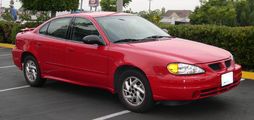
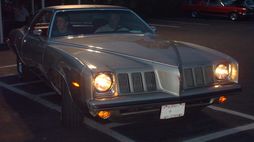
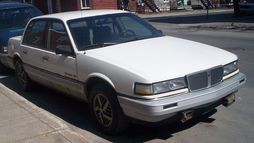
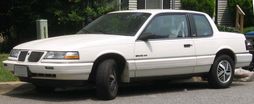
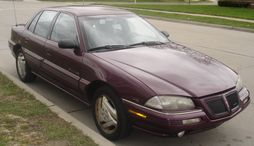
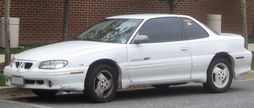
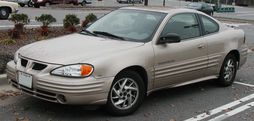
|